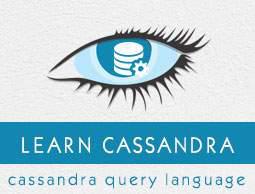Cassandra - Alter Keyspace
Altering a KeySpace
ALTER KEYSPACE can be used to alter properties such as the number of replicas and the durable_writes of a KeySpace. Given below is the syntax of this command.
Syntax
ALTER KEYSPACE <identifier> WITH <properties>
i.e.
ALTER KEYSPACE “KeySpace Name”
WITH replication = {'class': ‘Strategy name’, 'replication_factor' : ‘No.Of replicas’};
The properties of ALTER KEYSPACE are same as CREATE KEYSPACE. It has two properties: replication and durable_writes.
Replication
The replication option specifies the replica placement strategy and the number of replicas wanted.
Durable_writes
Using this option, you can instruct Cassandra whether to use commitlog for updates on the current KeySpace. This option is not mandatory and by default, it is set to true.
Example
Given below is an example of altering a KeySpace.
cqlsh.> ALTER KEYSPACE howcodex
WITH replication = {'class':'NetworkTopologyStrategy', 'replication_factor' : 3};
Altering Durable_writes
You can also alter the durable_writes property of a KeySpace. Given below is the
durable_writes property of the test KeySpace.
SELECT * FROM system.schema_keyspaces;
keyspace_name | durable_writes | strategy_class | strategy_options
----------------+----------------+------------------------------------------------------+----------------------------
test | False | org.apache.cassandra.locator.NetworkTopologyStrategy | {"datacenter1":"3"}
howcodex | True | org.apache.cassandra.locator.SimpleStrategy | {"replication_factor":"4"}
system | True | org.apache.cassandra.locator.LocalStrategy | { }
system_traces | True | org.apache.cassandra.locator.SimpleStrategy | {"replication_factor":"2"}
(4 rows)
ALTER KEYSPACE test
WITH REPLICATION = {'class' : 'NetworkTopologyStrategy', 'datacenter1' : 3}
AND DURABLE_WRITES = true;
Once again, if you verify the properties of KeySpaces, it will produce the following output.
SELECT * FROM system.schema_keyspaces;
keyspace_name | durable_writes | strategy_class | strategy_options
----------------+----------------+------------------------------------------------------+----------------------------
test | True | org.apache.cassandra.locator.NetworkTopologyStrategy | {"datacenter1":"3"}
howcodex | True | org.apache.cassandra.locator.SimpleStrategy | {"replication_factor":"4"}
system | True | org.apache.cassandra.locator.LocalStrategy | { }
system_traces | True | org.apache.cassandra.locator.SimpleStrategy | {"replication_factor":"2"}
(4 rows)
Altering a Keyspace using Java API
You can alter a keyspace using the execute() method of Session class. Follow the steps given below to alter a keyspace using Java API
Step1: Create a Cluster Object
First of all, create an instance of Cluster.builder class of com.datastax.driver.core package as shown below.
//Creating Cluster.Builder object
Cluster.Builder builder1 = Cluster.builder();
Add a contact point (IP address of the node) using the addContactPoint() method of Cluster.Builder object. This method returns Cluster.Builder.
//Adding contact point to the Cluster.Builder object
Cluster.Builder builder2 = build.addContactPoint( "127.0.0.1" );
Using the new builder object, create a cluster object. To do so, you have a method called build() in the Cluster.Builder class. The following code shows how to create a cluster object.
//Building a cluster
Cluster cluster = builder.build();
You can build the cluster object using a single line of code as shown below.
Cluster cluster = Cluster.builder().addContactPoint("127.0.0.1").build();
Step 2: Create a Session Object
Create an instance of Session object using the connect() method of Clusterclass as shown below.
Session session = cluster.connect( );
This method creates a new session and initializes it. If you already have a keyspace, you can set it to the existing one by passing the keyspace name in string format to this method as shown below.
Session session = cluster.connect(“ Your keyspace name ” );
Step 3: Execute Query
You can execute CQL queries using the execute() method of Session class. Pass the query either in string format or as a Statement class object to the execute() method. Whatever you pass to this method in string format will be executed on the cqlsh.
In this example,
You have to store the query in a string variable and pass it to the execute() method as shown below.
//Query
String query = "ALTER KEYSPACE tp WITH replication " + "= {'class':'NetworkTopologyStrategy', 'datacenter1':3}" +" AND DURABLE_WRITES = false;";
session.execute(query);
Given below is the complete program to create and use a keyspace in Cassandra using Java API.
import com.datastax.driver.core.Cluster;
import com.datastax.driver.core.Session;
public class Alter_KeySpace {
public static void main(String args[]){
//Query
String query = "ALTER KEYSPACE tp WITH replication " + "= {'class':'NetworkTopologyStrategy', 'datacenter1':3}"
+ "AND DURABLE_WRITES = false;";
//Creating Cluster object
Cluster cluster = Cluster.builder().addContactPoint("127.0.0.1").build();
//Creating Session object
Session session = cluster.connect();
//Executing the query
session.execute(query);
System.out.println("Keyspace altered");
}
}
Save the above program with the class name followed by .java, browse to the location where it is saved. Compile and execute the program as shown below.
$javac Alter_KeySpace.java
$java Alter_KeySpace
Under normal conditions, it produces the following output −
Keyspace Altered


